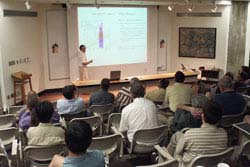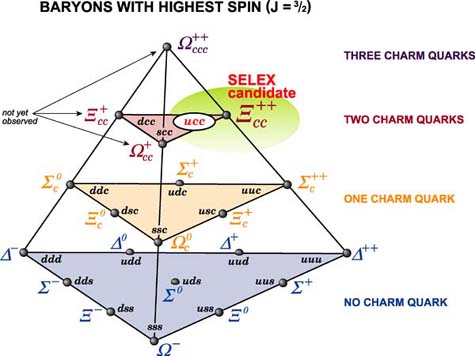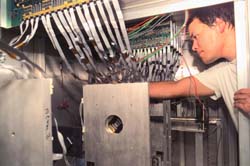 |
|
Extended Family?Physicists report signs of new relatives of the proton by Kurt Riesselmann
On Friday, May 31, a group of physicists presented the results of a year-long analysis of an experiment carried out at the Department of Energy's Fermi National Accelerator Laboratory. Sifting through the data of particle collisions in which they produced particles made of three quarks, the experimenters found signals that indicate the creation of new particles with quark combinations never observed before. However, experimenters emphasized that significant questions remain in the interpretation of these results.
Jim Russ, cospokesperson of the SELEX collaboration, announced the new results to a group of 90 scientists during a seminar at Fermilab.
"Baryon" is expert's lingo for a class of particles composed of three quarks. Protons and neutrons are the most frequent baryons occurring in nature, accounting for almost all matter on earth. Since quarks, the fundamental building blocks of matter, come in six different types, scientists have predicted many other three-quark combinations to exist, including baryons with two charm quarks, which SELEX scientists may finally have seen.
"People have observed charmed baryons in the past, but not with two charm quarks," said Mark Mattson, who wrote his Ph.D. thesis about this particle search. "Since there were rough predictions of their properties, we had an idea about how to look for them and what sort of particles they would decay into."
In the last 30 years, scientists have conducted increasingly sophisticated experiments to produce the various types of three-quark systems expected to exist. Similar to the periodic table of atoms, particle physicists have identified a classification scheme for baryons. The endeavor of creating the heaviest of these quark-composite particles, however, is challenging, comparable to the quest for the heaviest, still-undiscovered elements of the periodic table.
"We're trying to understand the structure of matter," said Fermilab physicist Peter Cooper, the second spokesperson of the SELEX collaboration, which comprises 130 scientists from 10 countries. "More than ninety-nine percent of what all of us are made of are protons and neutrons. They are composite objects, sort of like atoms. The question is: How are they put together? What is their structure? What is the nature of the forces that hold them together? By studying various baryons, we learn something about the family traits."
The SELEX collaboration includes 130 scientists from 10 countries:
Using detector components built at physics laboratories in Russia, Germany, Brazil, Italy and the United States, the SELEX experimenters recorded in 1996 one billion collisions of high-energy particles with a diamond target. Physicists searched the resulting data for easily identifiable particles, and then linked the tracks of different particles to reconstruct decays of heavy, very short-lived baryons. Over five years, the collaboration steadily developed the tools to look for more and more complicated decay patterns. Last year, physicists finally applied their latest tools to a sample of singly charmed baryons, which are the key to identifying doubly charmed baryons.
Finding ingredients of the big bang
The SELEX experimenters think they now can fill a few blanks in the baryon classification tables. Their analysis indicates the existence of doubly charmed Xi (pronounced sigh) particles, a type of baryon that may not have been produced in nature since the very first minutes after the creation of the universe, the Big Bang. Based on Mattson's Ph.D. research, a thorough analysis of the SELEX signals has revealed candidates for two different types of doubly charmed baryons. One type has an up quark in conjunction with two charm quarks (u-c-c combination), and the other one contains a down quark as third constituent (d-c-c). The s-c-c baryon, which includes a strange quark, and the all-charm combination (c-c-c) are still eluding detection.
"If any of these states didn't exist it would be miraculous," Cooper said. "This is the quark model, the extension of the theory that Murray Gell-Mann won the Nobel Prize for.
"There are four different quark flavors that can contribute at the energies used in our experiment, and we ask: how many ways can we combine them to make up all the possible baryons. If one of these combinations didn't exist in nature, there would have to be some very fundamental reason why."
The four flavors - up, down, strange, charm - allow for twenty different ways of putting quarks together to form baryons (see graphic). Protons, for example, consist of two up quarks and one down quark
(u-u-d), and neutrons have a u-d-d quark content. Some combinations exist in two different spin configurations, and the SELEX collaboration believes it has identified both spin levels of the u-c-c baryon.
Because charm quarks are much heavier than up, down and strange quarks, the doubly charmed baryons are more difficult to produce. The SELEX data, for example, indicates the u-c-c baryon mass to be about four times larger than the proton's, making the particle as heavy as an entire helium atom.
The two heaviest quark flavors, called top and bottom, weigh too much to contribute to the SELEX data. Scientists, however, already predict that a new generation of Fermilab experiments, currently recording data, will reveal baryons containing bottom quarks in combinations never seen before.
Questions remain
Although the SELEX analysis has convincingly shown the existence of three high-mass particles, the collaboration is still trying to understand some surprising findings. The mass difference among the new baryons, for example, doesn't quite match theoretical mass predictions for doubly charmed baryons.
"Based on particles already found, you can extrapolate to what these particles should behave like," Mattson said. "Our findings don't quite satisfy all predicted properties."
Physicists expect the mass difference between u-c-c and d-c-c baryons to be comparable to the difference in proton (u-u-d) and neutron (u-d-d) mass, since this particle pair is also related by the replacement of an up by a down quark. The proton-neutron mass splitting, however, is sixty times smaller than the mass difference between the Xi_cc candidates observed by the SELEX collaboration.
"That's huge," Russ pointed out. "On the other hand, this may reflect on the dynamics of particles with two charm quarks. Nobody else has ever measured baryons with two heavy quarks."
Fermilab theorist Estia Eichten, who attended the seminar, was one of many scientists viewing the large mass difference with skepticism. During the question-and-answer session at the end of the seminar, he promised to provide the collaboration with some theoretical input.
"[The mass splitting] is probably calculable," he said. "I'll do the calculation."
Other questions, however, remain as well. The SELEX collaboration is puzzled by the high rate of doubly charmed baryons seen in their experiment. As a matter of fact, most scientists believed that the SELEX collaboration wouldn't see any of these particles.
It wouldn't be the first time that charmed baryons have provided the physics community with a big surprise. In 1985, nobody expected Experiment WA62, carried out at the European accelerator laboratory CERN, to discover single-charmed baryons. But the production rate turned out to be much larger than predicted.
Is the story repeating itself at SELEX?
Peer review essential
In addition to the talk at Fermilab, which is available on the Internet as streaming video, the SELEX collaboration will present its results at a physics conference in Vancouver, Canada, at the end of June. And Cooper expects that he'll be talking to physicists of the BaBar and Belle collaborations, which currently record particle collisions at accelerators in California and Japan. Although their experiments focus on the production of baryons involving bottom quarks, those scientists may find a large number of doubly charmed baryons hidden in their data if the surprisingly large production rate of these particles is confirmed.
If the new results withstand the first critical review by peer scientists, the SELEX collaboration will submit an article for publication in a scientific journal.
"We are just beginning to draft this thing," Cooper said. And he added with a smile: "To get a paper out of a collaboration - it's sometimes easier to have a child!"
After analyzing one billion particle collisions, writing a paper should actually seem like a piece of cake.
On the Web:
The SELEX Homepage:
The Classification of Particles:
The Quark Dance:
|
 "Our analysis has reached a point of maturity," said Russ, physics professor at Carnegie Mellon University. "We believe that we have found three candidates for doubly-charmed baryons. But there are many puzzling aspects that remain."
"Our analysis has reached a point of maturity," said Russ, physics professor at Carnegie Mellon University. "We believe that we have found three candidates for doubly-charmed baryons. But there are many puzzling aspects that remain."

 "Many years ago, there was one paper in which - based on certain theoretical assumptions - the authors came right out and said it is impossible for SELEX to find this," Mattson recalled. "Fortunately, there are complementary experiments, like FOCUS (at Fermilab) and CLEO (at Cornell University), that can perhaps look for these signals. And future experiments should have enough data to verify our findings, too."
"Many years ago, there was one paper in which - based on certain theoretical assumptions - the authors came right out and said it is impossible for SELEX to find this," Mattson recalled. "Fortunately, there are complementary experiments, like FOCUS (at Fermilab) and CLEO (at Cornell University), that can perhaps look for these signals. And future experiments should have enough data to verify our findings, too."
 "At this point, we have to get some feedback to understand where we are," said Cooper, explaining why the collaboration decided to go public. "If this is real, then there is lots of work for us to do, and there is lots of work for other people to do. We should exploit this, trying to learn everything we can from the data we have. We already have evidence for three states that nobody has seen before, which is an awful lot in one go. Right now, it is sort of time for a reality check."
"At this point, we have to get some feedback to understand where we are," said Cooper, explaining why the collaboration decided to go public. "If this is real, then there is lots of work for us to do, and there is lots of work for other people to do. We should exploit this, trying to learn everything we can from the data we have. We already have evidence for three states that nobody has seen before, which is an awful lot in one go. Right now, it is sort of time for a reality check."